2006 INFINITI M35 ignition
[x] Cancel search: ignitionPage 5550 of 5621
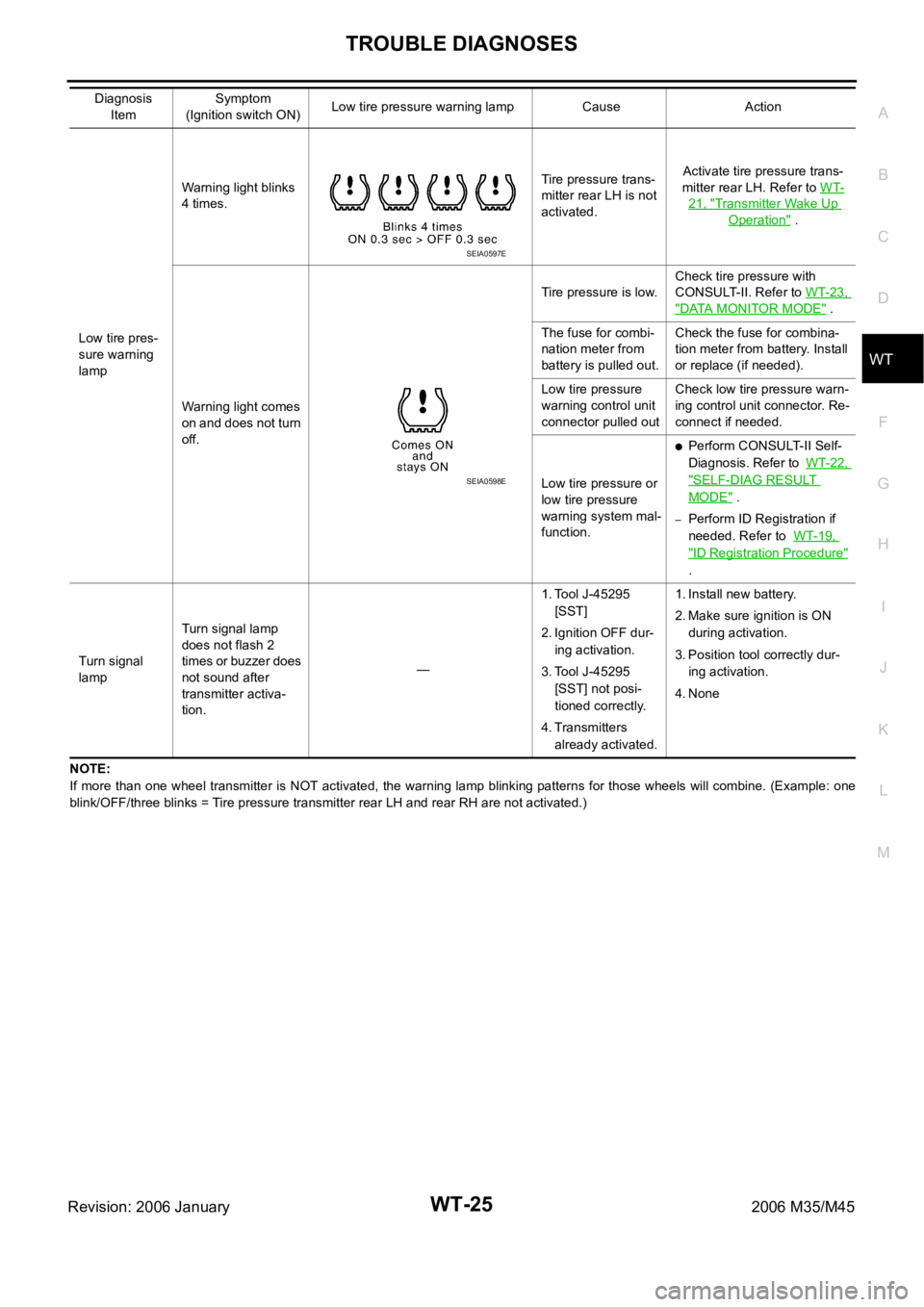
TROUBLE DIAGNOSES
WT-25
C
D
F
G
H
I
J
K
L
MA
B
WT
Revision: 2006 January2006 M35/M45
NOTE:
If more than one wheel transmitter is NOT activated, the warning lamp blinking patterns for those wheels will combine. (Example: one
blink/OFF/three blinks = Tire pressure transmitter rear LH and rear RH are not activated.) Low tire pres-
sure warning
lampWarning light blinks
4 times.Tire pressure trans-
mitter rear LH is not
activated.Activate tire pressure trans-
mitter rear LH. Refer to WT-
21, "Transmitter Wake Up
Operation" .
Warning light comes
on and does not turn
off.Tire pressure is low.Check tire pressure with
CONSULT-II. Refer to WT-23,
"DATA MONITOR MODE" .
The fuse for combi-
nation meter from
battery is pulled out.Check the fuse for combina-
tion meter from battery. Install
or replace (if needed).
Low tire pressure
warning control unit
connector pulled outCheck low tire pressure warn-
ing control unit connector. Re-
connect if needed.
Low tire pressure or
low tire pressure
warning system mal-
function.
Perform CONSULT-II Self-
Diagnosis. Refer to WT-22,
"SELF-DIAG RESULT
MODE" .
–Perform ID Registration if
needed. Refer to WT-19,
"ID Registration Procedure"
.
Turn signal
lampTurn signal lamp
does not flash 2
times or buzzer does
not sound after
transmitter activa-
tion.—1. Tool J-45295
[SST]
2. Ignition OFF dur-
ing activation.
3. Tool J-45295
[SST] not posi-
tioned correctly.
4. Transmitters
already activated.1. Install new battery.
2. Make sure ignition is ON
during activation.
3. Position tool correctly dur-
ing activation.
4. None Diagnosis
ItemSymptom
(Ignition switch ON)Low tire pressure warning lamp Cause Action
SEIA0597E
SEIA0598E
Page 5552 of 5621
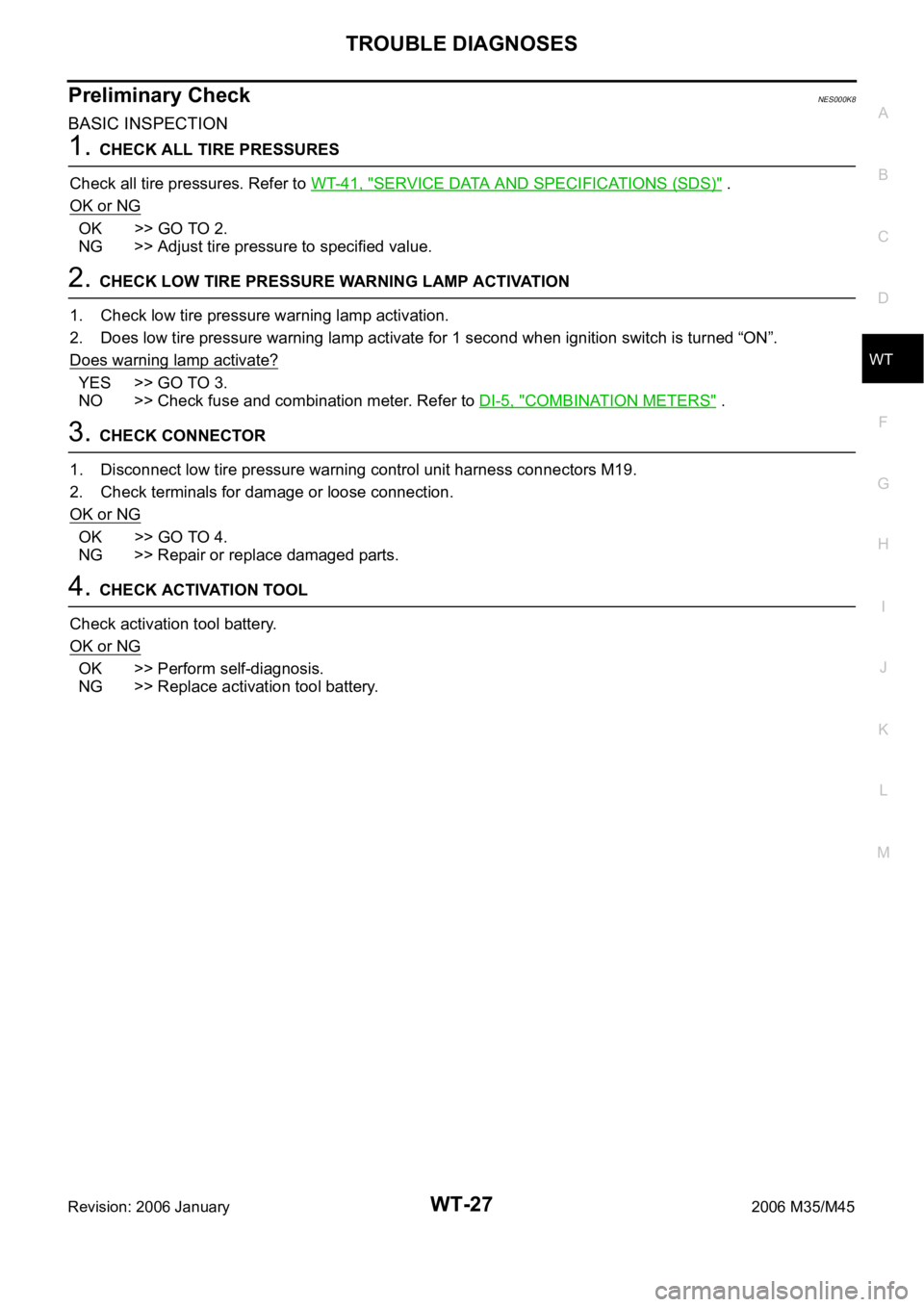
TROUBLE DIAGNOSES
WT-27
C
D
F
G
H
I
J
K
L
MA
B
WT
Revision: 2006 January2006 M35/M45
Preliminary CheckNES000K8
BASIC INSPECTION
1. CHECK ALL TIRE PRESSURES
Check all tire pressures. Refer to WT-41, "
SERVICE DATA AND SPECIFICATIONS (SDS)" .
OK or NG
OK >> GO TO 2.
NG >> Adjust tire pressure to specified value.
2. CHECK LOW TIRE PRESSURE WARNING LAMP ACTIVATION
1. Check low tire pressure warning lamp activation.
2. Does low tire pressure warning lamp activate for 1 second when ignition switch is turned “ON”.
Does warning lamp activate?
YES >> GO TO 3.
NO >> Check fuse and combination meter. Refer to DI-5, "
COMBINATION METERS" .
3. CHECK CONNECTOR
1. Disconnect low tire pressure warning control unit harness connectors M19.
2. Check terminals for damage or loose connection.
OK or NG
OK >> GO TO 4.
NG >> Repair or replace damaged parts.
4. CHECK ACTIVATION TOOL
Check activation tool battery.
OK or NG
OK >> Perform self-diagnosis.
NG >> Replace activation tool battery.
Page 5554 of 5621

TROUBLE DIAGNOSES
WT-29
C
D
F
G
H
I
J
K
L
MA
B
WT
Revision: 2006 January2006 M35/M45
DIAGNOSIS CHART BY SYMPTOM
Symptom Reference
Warning lamp does not come on when ignition switch is turned on.WT-35, "
Inspection 1: Warning Lamp Does Not Come On
When Ignition Switch Is Turned On"
Warning lamp stays on when ignition switch is turned on.WT-36, "Inspection 2: Warning Lamp Stays On When Ignition
Switch Is Turned On"
Warning lamp blinks when ignition switch is turned onWT-37, "Inspection 3: Warning Lamp Blinks When Ignition
Switch Is Turned On"
Turn signal lamp blinks when ignition switch is turned onWT-37, "Inspection 4: Turn Signal Lamp Blinks When Ignition
Switch Is Turned On"
ID registration can not be operated.WT-38, "Inspection 5: ID Registration Can Not Be Completed"
Page 5556 of 5621
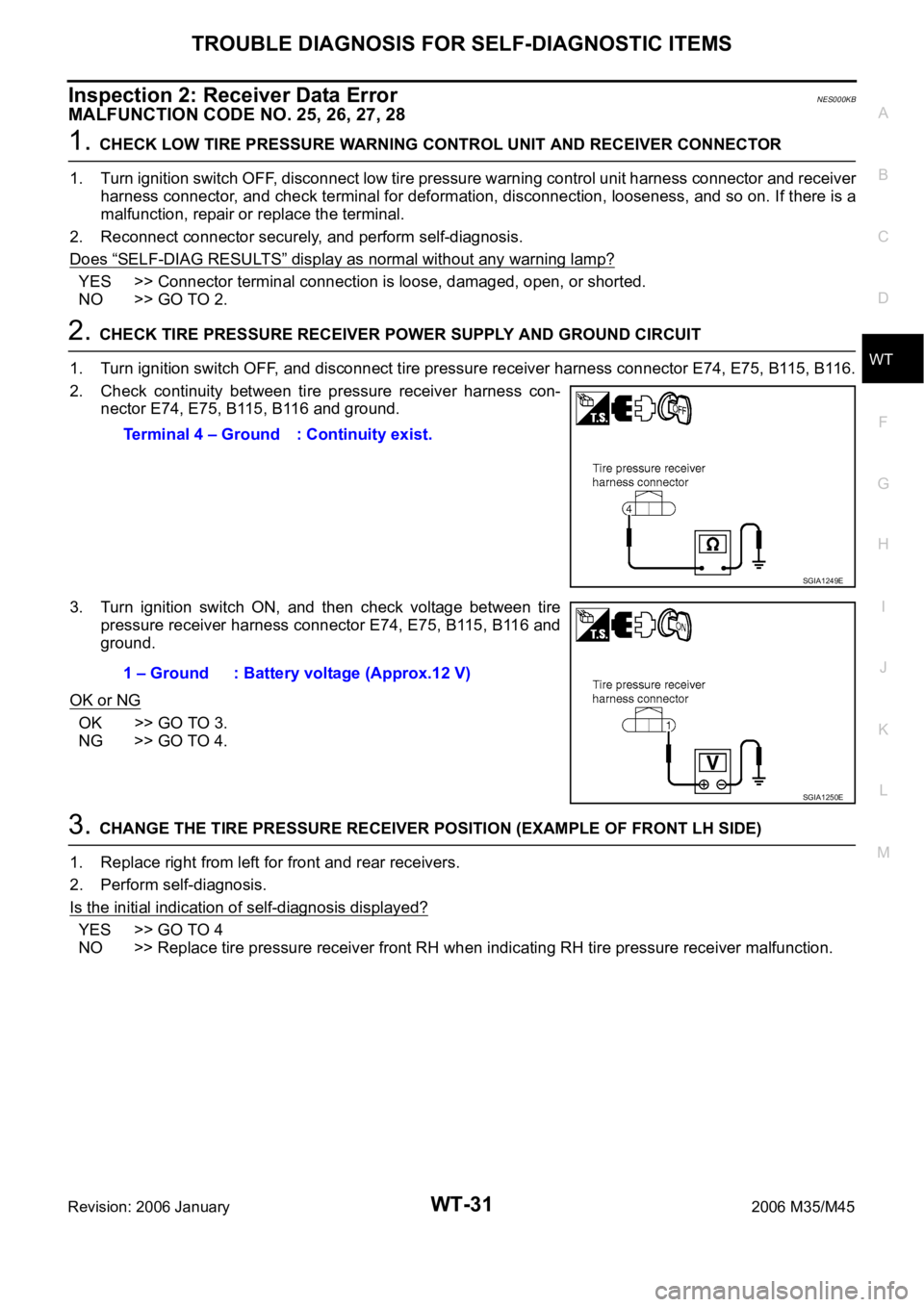
TROUBLE DIAGNOSIS FOR SELF-DIAGNOSTIC ITEMS
WT-31
C
D
F
G
H
I
J
K
L
MA
B
WT
Revision: 2006 January2006 M35/M45
Inspection 2: Receiver Data ErrorNES000KB
MALFUNCTION CODE NO. 25, 26, 27, 28
1. CHECK LOW TIRE PRESSURE WARNING CONTROL UNIT AND RECEIVER CONNECTOR
1. Turn ignition switch OFF, disconnect low tire pressure warning control unit harness connector and receiver
harness connector, and check terminal for deformation, disconnection, looseness, and so on. If there is a
malfunction, repair or replace the terminal.
2. Reconnect connector securely, and perform self-diagnosis.
Does
“SELF-DIAG RESULTS” display as normal without any warning lamp?
YES >> Connector terminal connection is loose, damaged, open, or shorted.
NO >> GO TO 2.
2. CHECK TIRE PRESSURE RECEIVER POWER SUPPLY AND GROUND CIRCUIT
1. Turn ignition switch OFF, and disconnect tire pressure receiver harness connector E74, E75, B115, B116.
2. Check continuity between tire pressure receiver harness con-
nector E74, E75, B115, B116 and ground.
3. Turn ignition switch ON, and then check voltage between tire
pressure receiver harness connector E74, E75, B115, B116 and
ground.
OK or NG
OK >> GO TO 3.
NG >> GO TO 4.
3. CHANGE THE TIRE PRESSURE RECEIVER POSITION (EXAMPLE OF FRONT LH SIDE)
1. Replace right from left for front and rear receivers.
2. Perform self-diagnosis.
Is the initial indication of self-diagnosis displayed?
YES >> GO TO 4
NO >> Replace tire pressure receiver front RH when indicating RH tire pressure receiver malfunction. Terminal 4 – Ground : Continuity exist.
SGIA1249E
1 – Ground : Battery voltage (Approx.12 V)
SGIA1250E
Page 5557 of 5621
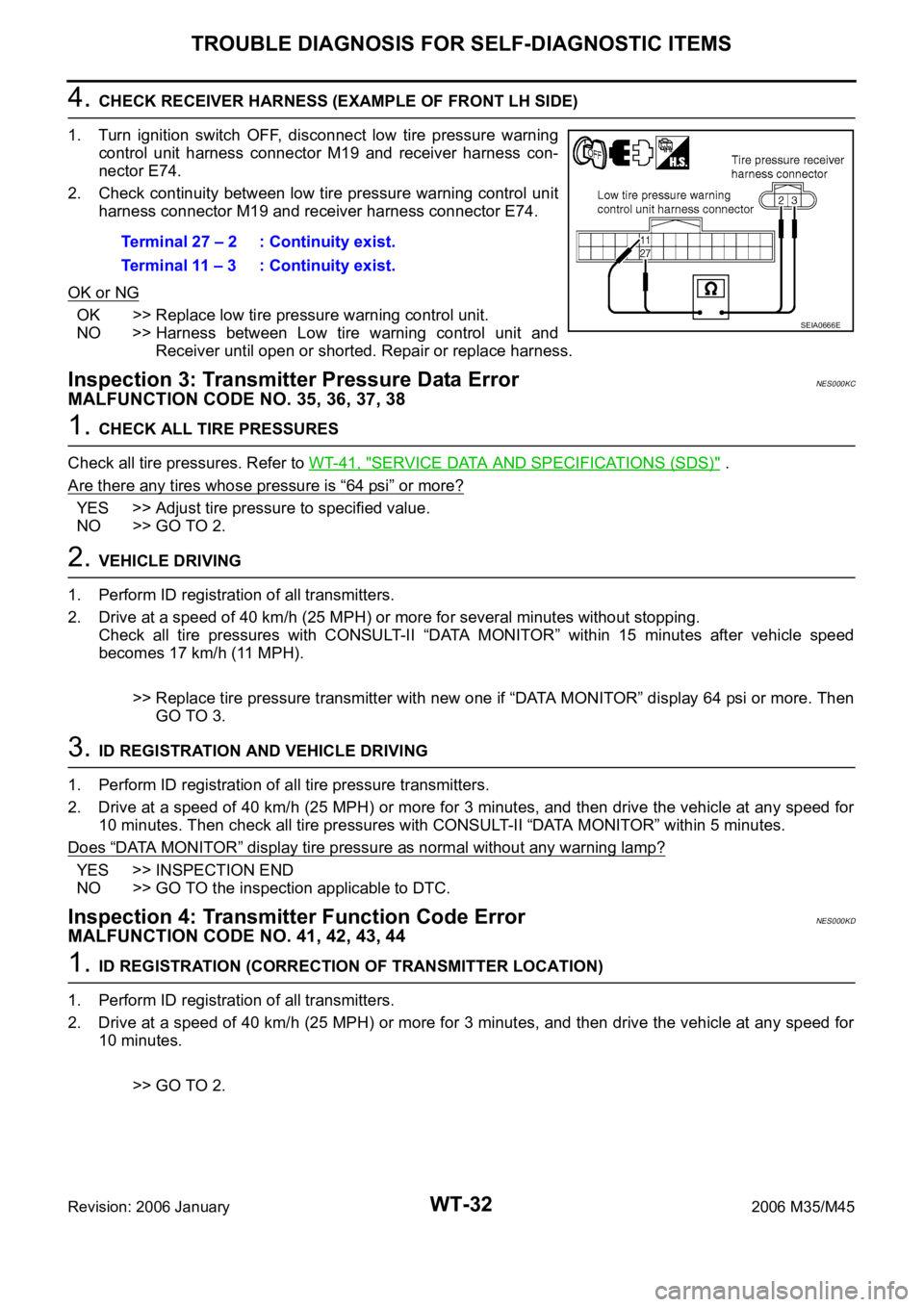
WT-32
TROUBLE DIAGNOSIS FOR SELF-DIAGNOSTIC ITEMS
Revision: 2006 January2006 M35/M45
4. CHECK RECEIVER HARNESS (EXAMPLE OF FRONT LH SIDE)
1. Turn ignition switch OFF, disconnect low tire pressure warning
control unit harness connector M19 and receiver harness con-
nector E74.
2. Check continuity between low tire pressure warning control unit
harness connector M19 and receiver harness connector E74.
OK or NG
OK >> Replace low tire pressure warning control unit.
NO >> Harness between Low tire warning control unit and
Receiver until open or shorted. Repair or replace harness.
Inspection 3: Transmitter Pressure Data ErrorNES000KC
MALFUNCTION CODE NO. 35, 36, 37, 38
1. CHECK ALL TIRE PRESSURES
Check all tire pressures. Refer to WT-41, "
SERVICE DATA AND SPECIFICATIONS (SDS)" .
Are there any tires whose pressure is
“64 psi” or more?
YES >> Adjust tire pressure to specified value.
NO >> GO TO 2.
2. VEHICLE DRIVING
1. Perform ID registration of all transmitters.
2. Drive at a speed of 40 km/h (25 MPH) or more for several minutes without stopping.
Check all tire pressures with CONSULT-II “DATA MONITOR” within 15 minutes after vehicle speed
becomes 17 km/h (11 MPH).
>> Replace tire pressure transmitter with new one if “DATA MONITOR” display 64 psi or more. Then
GO TO 3.
3. ID REGISTRATION AND VEHICLE DRIVING
1. Perform ID registration of all tire pressure transmitters.
2. Drive at a speed of 40 km/h (25 MPH) or more for 3 minutes, and then drive the vehicle at any speed for
10 minutes. Then check all tire pressures with CONSULT-II “DATA MONITOR” within 5 minutes.
Does
“DATA MONITOR” display tire pressure as normal without any warning lamp?
YES >> INSPECTION END
NO >> GO TO the inspection applicable to DTC.
Inspection 4: Transmitter Function Code ErrorNES000KD
MALFUNCTION CODE NO. 41, 42, 43, 44
1. ID REGISTRATION (CORRECTION OF TRANSMITTER LOCATION)
1. Perform ID registration of all transmitters.
2. Drive at a speed of 40 km/h (25 MPH) or more for 3 minutes, and then drive the vehicle at any speed for
10 minutes.
>> GO TO 2. Terminal 27 – 2 : Continuity exist.
Terminal 11 – 3 : Continuity exist.
SEIA0666E
Page 5559 of 5621
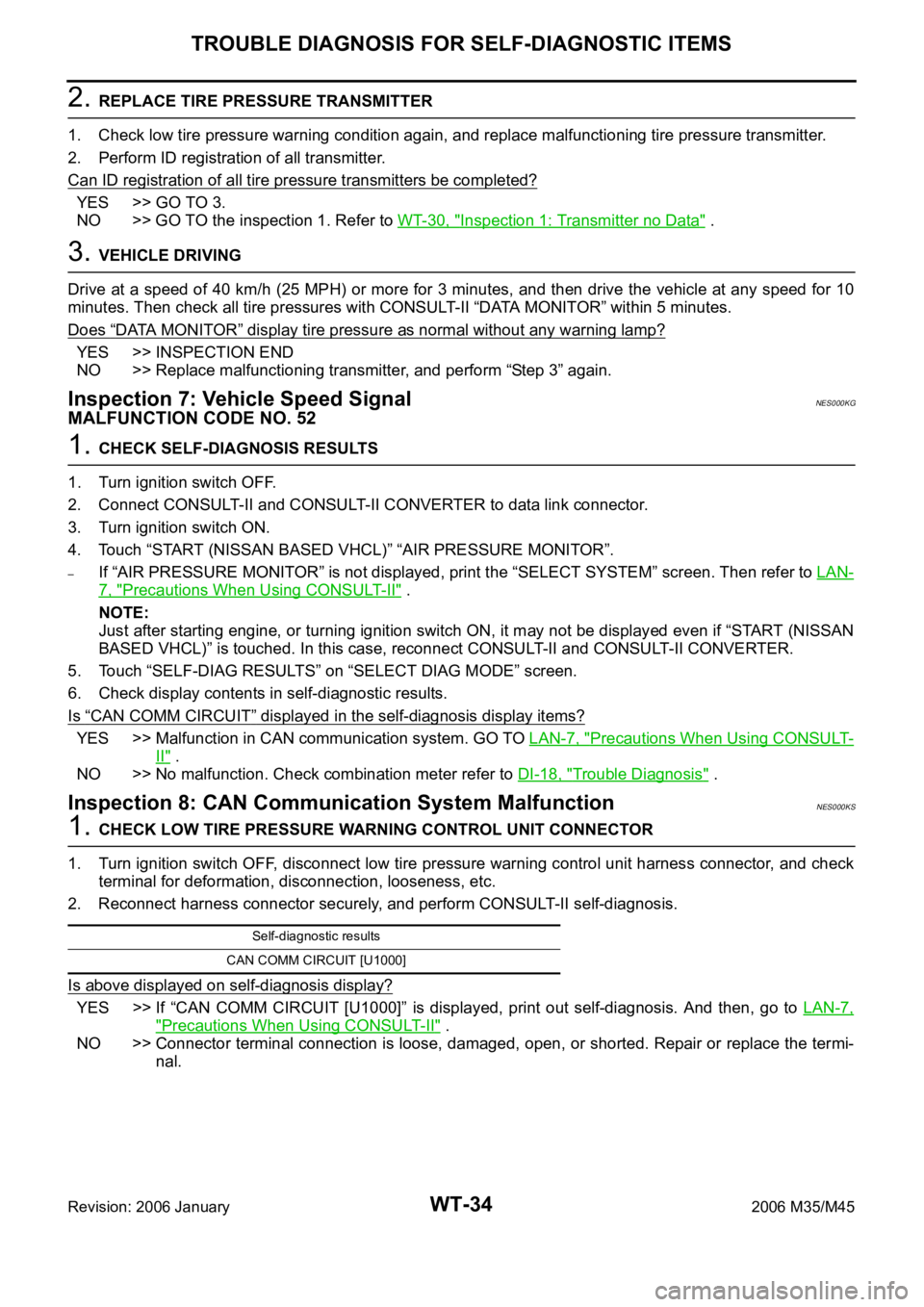
WT-34
TROUBLE DIAGNOSIS FOR SELF-DIAGNOSTIC ITEMS
Revision: 2006 January2006 M35/M45
2. REPLACE TIRE PRESSURE TRANSMITTER
1. Check low tire pressure warning condition again, and replace malfunctioning tire pressure transmitter.
2. Perform ID registration of all transmitter.
Can ID registration of all tire pressure transmitters be completed?
YES >> GO TO 3.
NO >> GO TO the inspection 1. Refer to WT-30, "
Inspection 1: Transmitter no Data" .
3. VEHICLE DRIVING
Drive at a speed of 40 km/h (25 MPH) or more for 3 minutes, and then drive the vehicle at any speed for 10
minutes. Then check all tire pressures with CONSULT-II “DATA MONITOR” within 5 minutes.
Does
“DATA MONITOR” display tire pressure as normal without any warning lamp?
YES >> INSPECTION END
NO >> Replace malfunctioning transmitter, and perform “Step 3” again.
Inspection 7: Vehicle Speed SignalNES000KG
MALFUNCTION CODE NO. 52
1. CHECK SELF-DIAGNOSIS RESULTS
1. Turn ignition switch OFF.
2. Connect CONSULT-II and CONSULT-II CONVERTER to data link connector.
3. Turn ignition switch ON.
4. Touch “START (NISSAN BASED VHCL)” “AIR PRESSURE MONITOR”.
–If “AIR PRESSURE MONITOR” is not displayed, print the “SELECT SYSTEM” screen. Then refer to LAN-
7, "Precautions When Using CONSULT-II" .
NOTE:
Just after starting engine, or turning ignition switch ON, it may not be displayed even if “START (NISSAN
BASED VHCL)” is touched. In this case, reconnect CONSULT-II and CONSULT-II CONVERTER.
5. Touch “SELF-DIAG RESULTS” on “SELECT DIAG MODE” screen.
6. Check display contents in self-diagnostic results.
Is
“CAN COMM CIRCUIT” displayed in the self-diagnosis display items?
YES >> Malfunction in CAN communication system. GO TO LAN-7, "Precautions When Using CONSULT-
II" .
NO >> No malfunction. Check combination meter refer to DI-18, "
Trouble Diagnosis" .
Inspection 8: CAN Communication System MalfunctionNES000KS
1. CHECK LOW TIRE PRESSURE WARNING CONTROL UNIT CONNECTOR
1. Turn ignition switch OFF, disconnect low tire pressure warning control unit harness connector, and check
terminal for deformation, disconnection, looseness, etc.
2. Reconnect harness connector securely, and perform CONSULT-II self-diagnosis.
Is above displayed on self-diagnosis display?
YES >> If “CAN COMM CIRCUIT [U1000]” is displayed, print out self-diagnosis. And then, go to LAN-7,
"Precautions When Using CONSULT-II" .
NO >> Connector terminal connection is loose, damaged, open, or shorted. Repair or replace the termi-
nal.
Self-diagnostic results
CAN COMM CIRCUIT [U1000]
Page 5560 of 5621
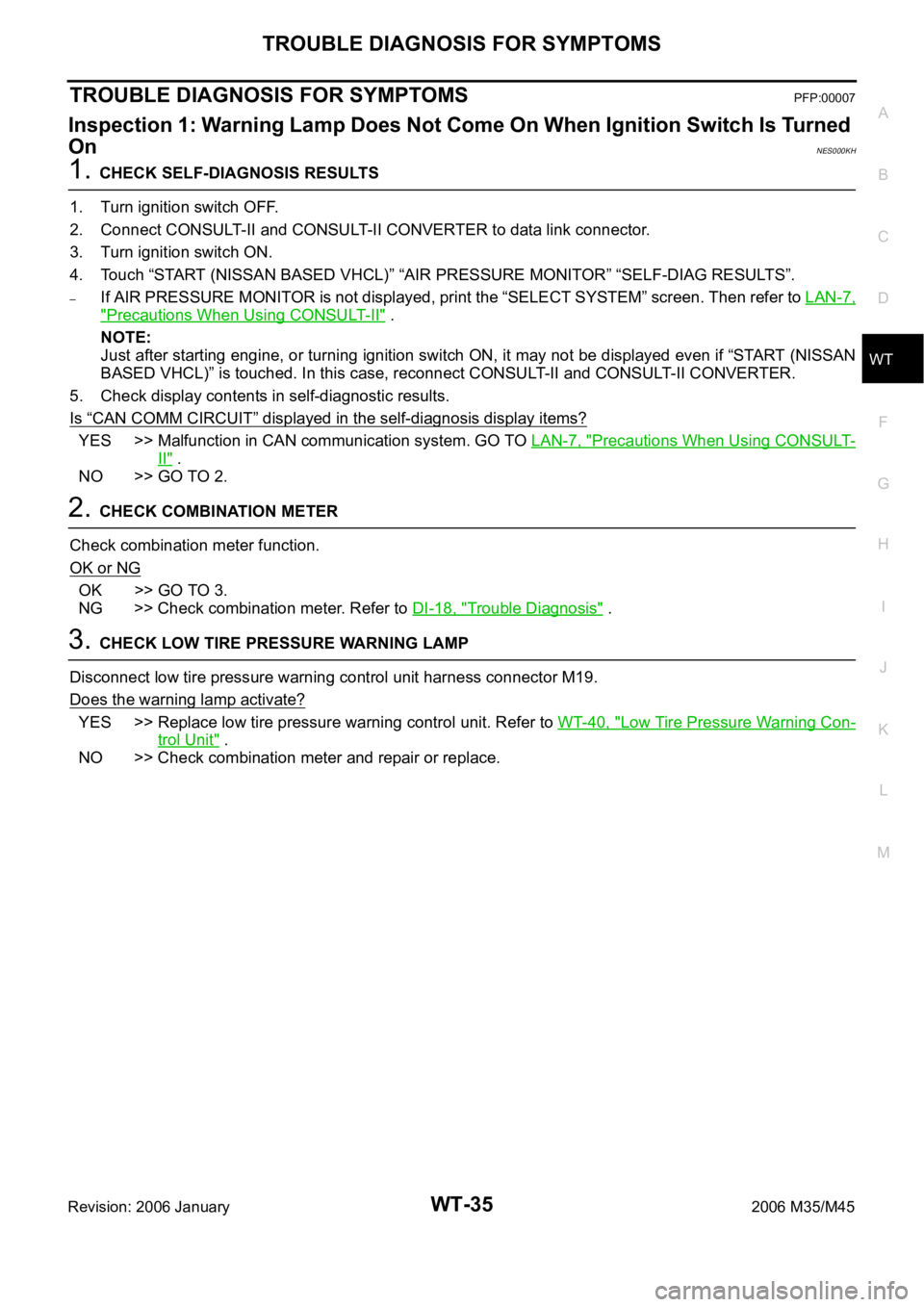
TROUBLE DIAGNOSIS FOR SYMPTOMS
WT-35
C
D
F
G
H
I
J
K
L
MA
B
WT
Revision: 2006 January2006 M35/M45
TROUBLE DIAGNOSIS FOR SYMPTOMSPFP:00007
Inspection 1: Warning Lamp Does Not Come On When Ignition Switch Is Turned
On
NES000KH
1. CHECK SELF-DIAGNOSIS RESULTS
1. Turn ignition switch OFF.
2. Connect CONSULT-II and CONSULT-II CONVERTER to data link connector.
3. Turn ignition switch ON.
4. Touch “START (NISSAN BASED VHCL)” “AIR PRESSURE MONITOR” “SELF-DIAG RESULTS”.
–If AIR PRESSURE MONITOR is not displayed, print the “SELECT SYSTEM” screen. Then refer to LAN-7,
"Precautions When Using CONSULT-II" .
NOTE:
Just after starting engine, or turning ignition switch ON, it may not be displayed even if “START (NISSAN
BASED VHCL)” is touched. In this case, reconnect CONSULT-II and CONSULT-II CONVERTER.
5. Check display contents in self-diagnostic results.
Is
“CAN COMM CIRCUIT” displayed in the self-diagnosis display items?
YES >> Malfunction in CAN communication system. GO TO LAN-7, "Precautions When Using CONSULT-
II" .
NO >> GO TO 2.
2. CHECK COMBINATION METER
Check combination meter function.
OK or NG
OK >> GO TO 3.
NG >> Check combination meter. Refer to DI-18, "
Trouble Diagnosis" .
3. CHECK LOW TIRE PRESSURE WARNING LAMP
Disconnect low tire pressure warning control unit harness connector M19.
Does the warning lamp activate?
YES >> Replace low tire pressure warning control unit. Refer to WT-40, "Low Tire Pressure Warning Con-
trol Unit" .
NO >> Check combination meter and repair or replace.
Page 5561 of 5621
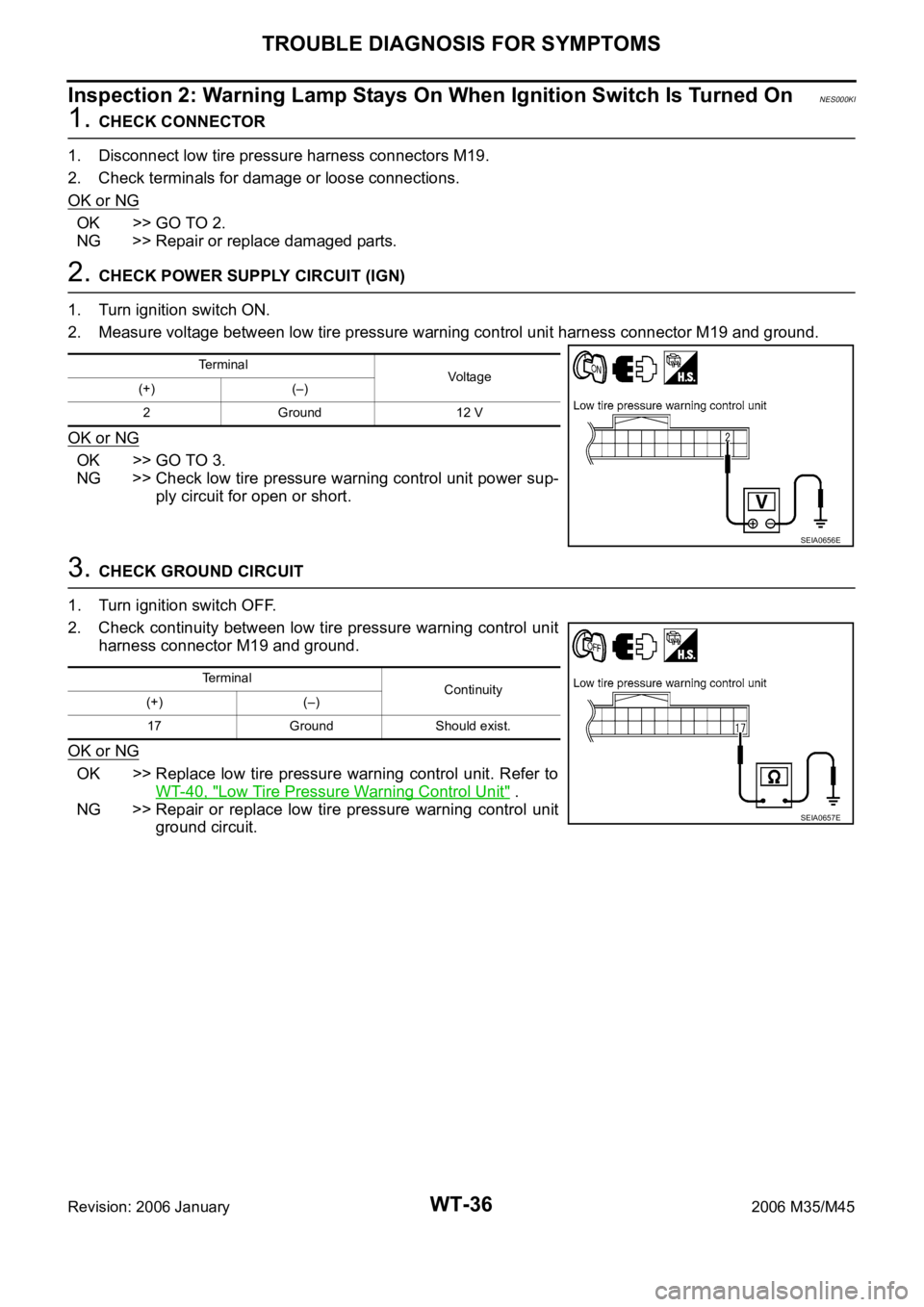
WT-36
TROUBLE DIAGNOSIS FOR SYMPTOMS
Revision: 2006 January2006 M35/M45
Inspection 2: Warning Lamp Stays On When Ignition Switch Is Turned OnNES000KI
1. CHECK CONNECTOR
1. Disconnect low tire pressure harness connectors M19.
2. Check terminals for damage or loose connections.
OK or NG
OK >> GO TO 2.
NG >> Repair or replace damaged parts.
2. CHECK POWER SUPPLY CIRCUIT (IGN)
1. Turn ignition switch ON.
2. Measure voltage between low tire pressure warning control unit harness connector M19 and ground.
OK or NG
OK >> GO TO 3.
NG >> Check low tire pressure warning control unit power sup-
ply circuit for open or short.
3. CHECK GROUND CIRCUIT
1. Turn ignition switch OFF.
2. Check continuity between low tire pressure warning control unit
harness connector M19 and ground.
OK or NG
OK >> Replace low tire pressure warning control unit. Refer to
WT-40, "
Low Tire Pressure Warning Control Unit" .
NG >> Repair or replace low tire pressure warning control unit
ground circuit.
Terminal
Vo l ta g e
(+) (–)
2 Ground 12 V
SEIA0656E
Terminal
Continuity
(+) (–)
17 Ground Should exist.
SEIA0657E